When and how to dig up tulip bulbs after flowering in summer: timing, storage methods until autumn planting
If the same dahlias and gladioli need to be dug up every fall in order to store during the winter, then tulips, on the contrary, are dug up to be stored at home during the summer, so that they can be subsequently planted in the fall.
You will learn about when and how to dig up tulip bulbs, how to store them correctly in summer, from this detailed article.
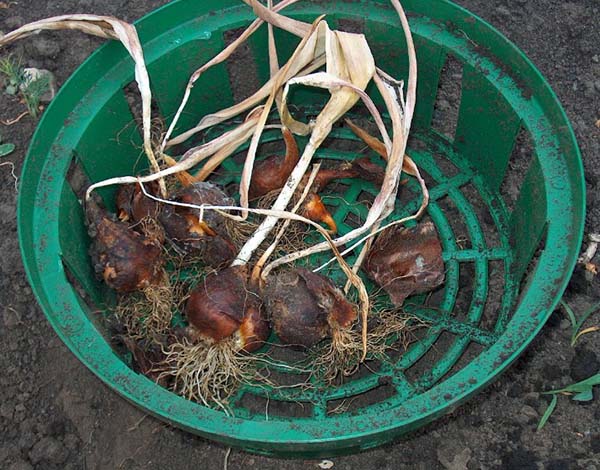
Content
Why dig up tulips after flowering in summer
If you do not periodically dig up tulip bulbs, then in a cool and rainy summer (for example, the same Central strip and Moscow region), they will simply bloom worse (for the successful formation of flower buds, a warm and dry period of rest is needed), besides, they can still deeply sink into the soil and then finally stop blooming.
Is it possible not to dig at all
If you have enough dry and warm climate in summer there is practically no rain, you don't have to dig up tulips every year.
Another thing is that once every 2-3 years, this should be done in order to divide, and also check the depth of their planting.
Naturally, if you are not digging tulips, then in no case should you water them after the leaves turn yellow.
However! Terry and fringed tulips definitely need to be dug up yearly... And here Darwin, Greig, Kaufman andFoster can be dug Once every 2-3 years.
When to dig tulip bulbs
You can only dig up tulips after they will fade, a the leaves will turn yellow and begin to dry out... This will mean that bulbs are fully ripe and ready to dig.
By the way!You can dig up one plant to check if it is done. Brown coverts (integumentary) flakes - a sure sign of good ripening of the bulb. On the contrary, if the scales are completely white, then this is a sign that the bulb is still developing.
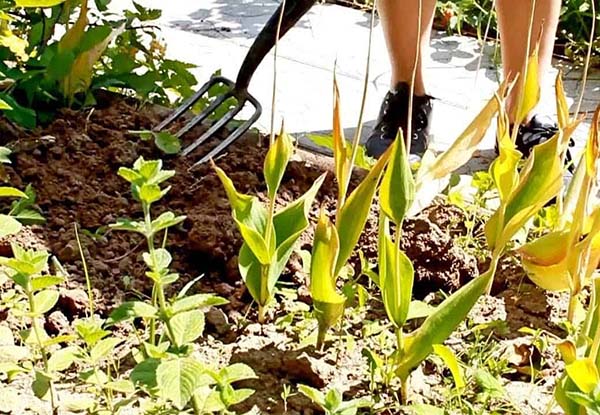
If the leaves are still green, this means that they are still supplying the bulb with food and it is just ripening.
Therefore, in no case remove the leaves ahead of time!
It's another matter if you are late. In this case, dry stems can simply fall off, and you will have to look for your bulbs by touch, which means there will be a high probability of damage when digging.
Concerning approximate dateswhen digging tulip bulbs, they usually do it 1-1.5 months after flowering, in other words, approximately at the end of May-June (but first of all it is recommended to pay attention to the appearance of the plant, and not to the calendar).
By the way! Since tulip varieties differ in flowering time (there are early, middle and late), respectively, and they need to be dug out at different times.
Video: when to dig tulips
Is it possible to dig ahead of time
Even if your tulips are very weak, you should not disturb them ahead of time, all the more strongly it is not recommended to transplant them. It is imperative to wait until the leaves turn yellow and dry, i.e. June.
Another thing is that you can feed them with the same nitrogen fertilizers, or even better with complex fertilizers (but strictly until they turn yellow).
What to do if you need to urgently transplant in the spring
If you still need to dig up tulips that are already blooming (or are still in the budding stage), then this is what you can do: cut off all the flowers, but leave the leaves, then dig it out strictly together with a large clod of earth and transplant (preferably in a shady place, or to a new permanent, but be sure to shade, for example, the same old sheet). After that it is good to water, then wait until the leaves turn yellow or even dry out completely, and then dig out. During this time, small replacement bulbs should form inside the old bulbs, so they need to be removed for storage.
Worth knowing! However, next year this tulip most likely will not bloom, because the bulb should gain strength.
What to do if you bought or received blooming tulips in spring
For example, if you were presented with blooming tulips with a bulb in a pot on March 8, then in order to preserve them, you need to cut off all the flowers (while leaving the leaves), then transfer to a larger pot (if this one is too small) and until yellowing leaves do not forget to water and feed. And then dig up and store in a dry, warm place until autumn planting in open ground.

How to properly dig up tulip bulbs and prepare them for storage
Besides the fact that you need to choose the right time, you also need to dig up the tulip bulbs correctly.
Here are some tips to help you avoid embarrassing mistakes when digging bulbs:
- Optimally choose a fine sunny day when the weather is dry.
If it has been raining recently, it is better to wait a couple of days so that the earth has time to dry out (otherwise it will simply be difficult for you to clear the bulbs from the earth).
- Dig should leisurely and very careful... Use a shovel (or pitchfork) vertically, stepping back from the stems by 10-15 cm and digging out an earthen lump.
Important! Under no circumstances should the shovel (forks) be placed at an angle, in which case you can easily damage the bulbs.
- Next you need shake the soil off the bulbs and separate the kids (moreover, small children can not be separated from the bulbs, but those that are larger are required).
Advice! If the earth did not completely fly off, for example, if it was damp, then the bulbs must be put in the shade, allowed to dry and the earth then will fall off by itself.
- Now it is necessary remove old roots and plant stems.
In a well-ripened bulb, they (roots) are perfectly separated, if it does not work out, then do this after drying.
- And then the most upper flaking scales.
How to prepare bulbs for summer storage: handling and drying
- If you notice any suspicious spots, mold on the surface of the bulb, in other words, signs of disease, then in this case it is necessary to pickle (process) the bulbs in fungicidal preparations (Maxim, Vitaros, Fundazol, copper sulfate).
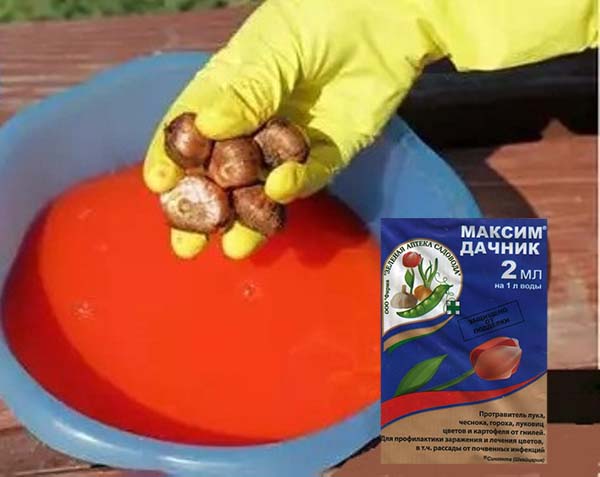
It is not recommended to use potassium permanganate as a dressing agent, because it is a very weak fungicide.
- Then the bulbs follow dryleaving on 2-3 days outdoorsbut necessarily in a shady place (as an option, under a canopy, the main thing is that there is no direct sunlight).
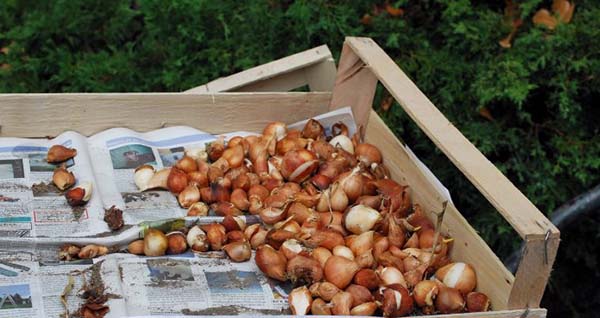
Methods for storing tulip bulbs before autumn planting
After you process and dry the bulbs, they will need to be removed in warm (optimum temperature is about + 25-30 degrees), dry and well-ventilated area (for example, in the attic or on the upper floor of the cottage) until the end of summer.
Note! Tulips are not stored in the basement, cellar or refrigerator.
As for storage containers, it is very convenient to use plastic boxes with holes (from under vegetables), in other words, there must be good air circulation so that moisture does not stagnate.

Alternatively, you can use cardboard egg trays.

By the way! Many initially plant tulips, crocuses, daffodils, hyacinths, lilies and other bulbous flowers in special boxes. This is very convenient because, firstly, excellent protection against miceand secondly, you can simply dig out the box, clear it of the earth and store the bulbs in it until the next planting.
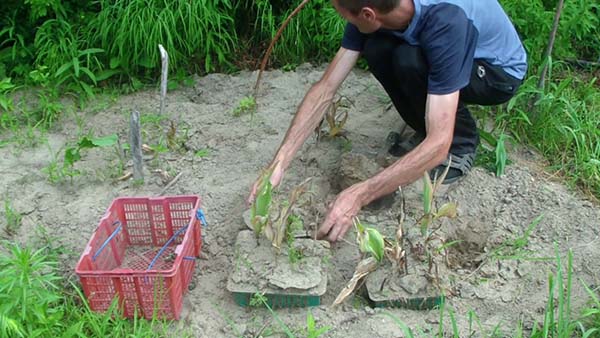
Thus, warmth, dryness and good airing are the 3 main ingredients for successful storage of tulip bulbs.
Advice! And here closer to autumn (i.e. until mid-August, when the heat reaches + 20-25 degrees) is very desirable lower the temperature in storage up to + 14-15 degrees (in fact, if you store the bulbs in a country house or in its attic, then it will fall by itself) so that the bulbs can more easily transfer the subsequent planting in cool soil.
Video: proper storage of tulip bulbs after digging
When and how to plant tulip bulbs outdoors in autumn
Tulips are always planted in the fall, at least 2 weeks before severe frosts, so that they have time to take root well.
Note! Find out more information about how when and how to plant and grow tulips, you can from this material.

Why tulips don't bloom
It so happens that in the past year everything was just fine: tulips bloomed profusely.And this year, mainly leaves came out, there were few buds, but they also wilted without blooming.
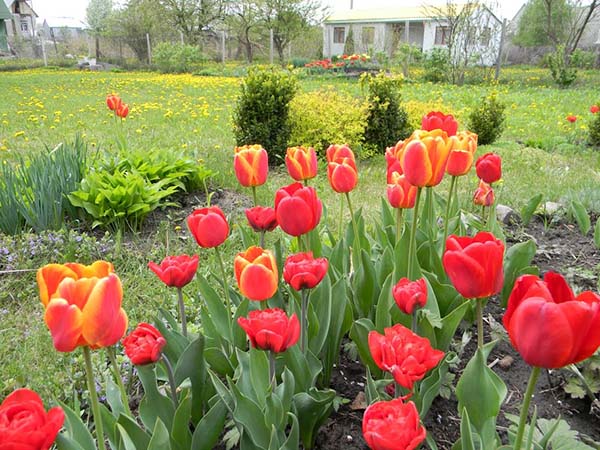
What happened? Why?
There may be several reasons why your tulips stopped blooming:
- Last season, you did not dig up the bulbs, although the soil in your area is too heavy, i.e. excessively clayey, and in summer it was damp (rainy and cool) = bulbs rotted.
- Dug up, but stored improperly (too low temperature).
- They were planted at the wrong depth: either they went too deep (the bulb was exhausted while driving the leaves to the surface), or, on the contrary, too close to the surface of the earth (the bulb could simply freeze in winter).
Thus, now you know why, when and how to dig up tulips in the summer after flowering, as well as how to properly store them until a new autumn planting in open ground. Good luck!
Video: how to dig up and store tulips

